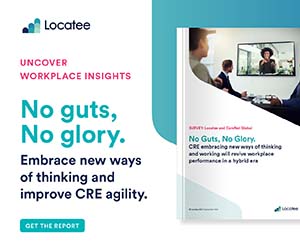The Great Resignation and the Impact on Real Estate Occupancy
For many years now, thereís been a steady and unprecedented rise in the number of highly valued and productive employees choosing to resign and invest in themselves rather than endure continued burnout from overwork, lack of support and recognition, lack of connection and shared values, underpay, and limited or no job flexibility.
The overwhelming results of employee surveys continue to show that well over half to as much as 80 percent of the professional workforce is actively looking for new opportunities and many are willing or likely to quit without having another job.
The Great Resignation has morphed into the Great Reset of employee attitudes and expectations, shifting from an employee mindset thatís historically been more compensation- focused to one thatís become more experienced-focused. In survey after survey, the employee holy grail is to be part of a work culture where they can learn, grow, and be challenged, have a sense of belonging and be themselves, and share values with leaders who walk the talk, day in and day out. These shifts in the priorities of the workforce have gone largely unaddressed, resulting in dramatic declines in employee engagement and retention that directly impact operating efficiency and costs, and company productivity, profitability, and competitiveness.
The pandemic and its lingering life of variants have added fuel to the resignation fire. It proved that working from home does work in the age of digital disruption and transformation. It uprooted the office as the centerpiece of work identity, collapsing and redefining the boundaries between leaders and their teams, work and home, and work time and personal/family time.  Since 2020, the greatest increase in resignations has been among mid-level professionals, ages 30 to 45, who represent the greatest investment in a companyís future. Accumulated burnout and the struggle to recruit and hire younger workers without in-office training and shadowing during the pandemic are most likely contributing factors.
Since 2020, the greatest increase in resignations has been among mid-level professionals, ages 30 to 45, who represent the greatest investment in a companyís future. Accumulated burnout and the struggle to recruit and hire younger workers without in-office training and shadowing during the pandemic are most likely contributing factors.
Weíre in the midst of a paradigm shift in how we think about work and what we want from it, and itís changing the terms of employment and the assurances employees want from their employers. They want company culture, practices, and policies to align with their more experience-focused mindset, and they want more say in defining and creating their own work patterns to support their wellbeing. That includes workplace options at home and closer to home, office environments that prioritize health hygiene and safety, work times that are more adaptable to personal and family needs, workspaces that can accommodate different work styles, and the choice to live in areas with less expensive housing costs than the location of the company headquarters.
This is driving more companies to change their workplace strategies and solutions to retain and attract the best employees. It can also prevent an exodus herd mentality that can come with high levels of turnover. The centralized office hub is being expanded to include more spokes in suburban locations. The one desk per person approach to space planning is being modified with more shared space. The fixed cost of a long-term lease is often being augmented or adjusted to include the variable cost of co-working. Flex space is serving as a buffer against the unpredictability of staffing levels and requirements and the variability of where people work.
The impact that this is having on real estate occupancy canít be overstated. JLL estimates that by the end of this decade, 30% of all office space will be flex space to help companies better match space consumption with space utilization and avoid underusing and overpaying for space they donít need. Itís estimated that 50% of all office lease transactions are for companies with less than 50 people and for less than 5,000 square feet, which is the sweet spot for co-working and flex space. And, small business formation has been surging, aided by e-commerce and the easy entry to low cost, tech ready, co-working space. That means building owners will need to offer co-working and flex space and become experts in managing it themselves or delivering it through providers and operators in order to compete for half the active office market.
Higher than average vacancy and sub-lease rates still persist from the effects of the pandemic, even though office leasing volumes are rising, occupancy loss is slowing, and sublease availability is contracting. As companies rethink their workplace strategies in response to the great resignation and the great reset of priorities of the workforce, they are developing multi-pronged workplace solutions in recognition of the fact that one size does not fit all. Nor does it have to. Hybrid workplace solutions that meet evolving company and employee preferences will play a critical role in fostering corporate culture, employee engagement and retention, and, ultimately, productivity and innovation.
The face and volatility of real estate occupancy are tied to the reshuffling of both the workforce and the workplace as companies sort out how and where their employees work and continue to tailor their real estate profile accordingly. The momentum and staying power of the great resignation is a sign that companies have not been sufficiently responsive to their employeesí needs and have not given them enough reason to stay. Leaders can begin to identify and reverse the root causes of declining employee engagement and retention by engaging with and listening to their employees to better understand what motivates them in todayís environment and what they need to be successful. That will help steer them towards a real estate footprint thatís sized and set up to function more effectively and will bring greater stability and predictability to both the workforce and the workplace.
This Week’s Sponsor
MRI Software delivers innovative applications and hosted solutions for real estate owners, operators, occupiers, and investors. Through a flexible technology platform and an open and connected ecosystem, MRI meets the unique needs of real estate businesses Ė from property-level management and accounting to investment modeling and analytics for the global commercial and residential markets. For more information, please visit www.mrisoftware.com.
Read Next
 5/15/2025
5/15/2025
Tech, Talent and Transformation: 2025 Digie Finalists Announced For 27 years, Realcomm has presented the Digie Awards to acknowledge companies, real estate projects, technologies, and individuals that have advanced the commercial real estate industry through the strategic use of technology, automation, and innovation.
 5/15/2025
5/15/2025
Empowering Space Management with Data-Driven Visualization For effective CRE space management, itís critical to centralize lease data, maximize rental square footage (RSF), improve energy efficiency and reconfigure spaces to meet changing needs.
 5/8/2025
5/8/2025
The AI-Powered Workplace Evolution: Redefining the Business Landscape In today's rapidly evolving business environment, the fusion of Artificial Intelligence (AI) and Workplace Management is revolutionizing the way organizations approach workspace optimization and operational efficiency.
 3/27/2025
3/27/2025
The Convergence of Edge Computing, Cloud, and AI in Building Automation and Smart Buildings In the built environment, we have seen the convergence of Operational Technology (OT) and Information Technology (IT), later expanding to include Workplace Technologies (WP).









%20(1)%20(1)%20(1).png)


